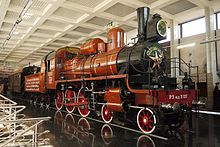
The transport network of the Russian Federation is one of the world's most extensive transport networks. The national web of roads, railways and airways stretches almost 7,700 km (4,800 mi) from Kaliningrad in the west to the Kamchatka Peninsula in the east, and major cities such as Moscow and Saint Petersburg are served by extensive rapid transit systems.
Transport in Turkmenistan includes roadways, railways, airways, seaways, and waterways, as well as oil-, gas-, and water pipelines. Road-, rail-, and waterway transport fall under the jurisdiction of the Ministry of Industry and Communications.

HS4000 Kestrel was a prototype high-powered mainline diesel locomotive that was built in 1967 by Brush Traction, Loughborough, as a technology demonstrator for potential future British Rail and export orders. The locomotive number is a combination of the initials of Hawker Siddeley and the power rating of its Sulzer diesel engine (4,000 hp), making it the most powerful locomotive built by the company.

The Islamic Republic of Iran Railways is the national state-owned railway system of Iran. The Raja Passenger Train Company is an associate of the IR, and manages its passenger trains. The Railway Transportation Company is an associate of the IR, which manages its freight transport. The Ministry of Roads & Urban Development is the state agency that oversees the IRIR. Some 33 million tonnes of goods and 29 million passengers are transported annually by the rail transportation network, accounting for 9 percent and 11 percent of all transportation in Iran, respectively (2011).

Russian Railways is a Russian fully state-owned vertically integrated railway company, both managing infrastructure and operating freight and passenger train services.

Rail transport in Ukraine is a major mode of transport in Ukraine. Most railway infrastructure in Ukraine is owned by the government of Ukraine through Ukrzaliznytsia, a joint-stock company which has a de facto country-wide monopoly on passenger and freight transport by rail.

Bogie exchange is a system for operating railway wagons on two or more gauges to overcome difference in the track gauge. To perform a bogie exchange, a car is converted from one gauge to another by removing the bogies or trucks, and installing a new bogie with differently spaced wheels. It is generally limited to wagons and carriages, though the bogies on diesel locomotives can be exchanged if enough time is available.

Rail transport in Slovakia began on September 21, 1840, with the opening of the first horse-powered line from Bratislava to Svätý Jur. The first steam-powered line, from Bratislava to Vienna, opened on August 20, 1848.

The Polish railways network consists of around 18,510 kilometres (11,500 mi) of track as of 2019, of which 11,998 km (7,455 mi) is electrified. The national electrification system runs at 3 kV DC.

Armenian Railways was a rail operator in Armenia.

The Soviet Union was heavily dependent on rail transport, not least during the Russian Civil War and World War II, but also for industrialization according to the five-year plans.

The Sakhalin–Hokkaido Tunnel is a proposed connection to link the Russian island of Sakhalin with the Japanese island of Hokkaido. Cost estimates by Russia in the year 2000 put the project to span the 45-kilometre (28-mile) strait at $50 billion.
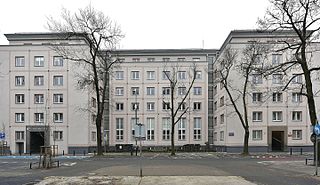
The Organization for Cooperation of Railways, was established as the equivalent of the International Union of Railways (UIC) to create and improve the coordination of international rail transport. Concerning especially the transports between Europe and Asia, it has helped develop cooperation between railway companies and with other international organisations. The members of this organisation created an international transport law.

Russia was and is the largest country in the world. Its geography of north–south rivers and east–west commerce, plus, importantly, the mostly flat terrain, made it very suited to develop railroads as the basic mode of transportation.
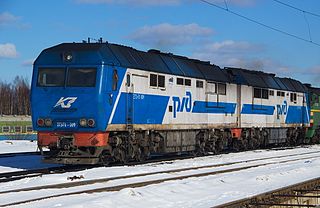
The 2TE70 is a Russian main line dual unit freight diesel locomotive, rated at 5,884 kW (7,891 hp). It has AC/DC transmission and individual axle traction control and is designed to haul freight trains on the Russian Federation lines RŽD with 1,520 mmRussian gauge. The 2ТE70 Freight diesel locomotive with two six-axle sections shares main parts with the TEP70 and TEP70BS passenger diesel locomotives. Each section is rated at 2,964 kW (3,975 hp) and it is designed for running freight trains of up to 6,000 t.

While the former Soviet Union got a late start with rail electrification in the 1926 it eventually became the world leader in electrification in terms of the volume of traffic under the wires. During its last 30 years the Soviet Union hauled about as much rail freight as all the other countries in the world combined and in the end, over 60% of this was by electric locomotives. Electrification was cost effective due to the very high density of traffic and was at times projected to yield at least a 10% return on electrification investment. By 1990, the electrification was about half 3 kV DC and half 25 kV AC 50 Hz and 70% of rail passenger-km was by electric railways.
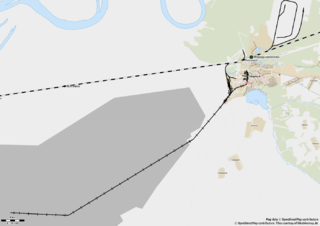
The Pishchalskoye peat railway is located in Kirov Oblast, Russia. The peat railway was opened in 1963 and has a total length of which 35 kilometres (22 mi) is currently operational; the track gauge is 750 mm.
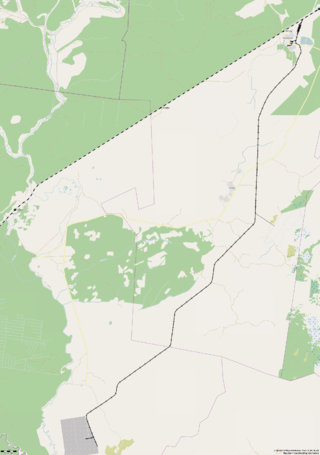
The Gorokhovskoye peat railway is located in Kirov Oblast, Russia. The peat railway was opened in 1960, and has a total length of which 35 kilometres (22 mi) is currently operational; the track gauge is 750 mm.
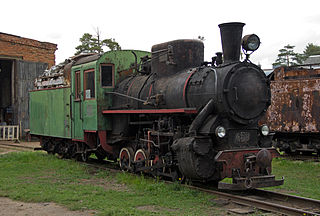
The Imperial Russian narrow railway track gauge was 3 ft 6 in, the current track gauge is predominantly 750 mm. In Soviet Russia, narrow-gauge railways were mostly common in forestry and peat industries in low inhabited places. Usually they have one main line and number of temporary branches. There was commonly a passenger service to villages and towns for workers.
Europe inherited a diversity of rail gauges. Extensive narrow-gauge railway networks exist in Spain, Central Europe and Southeastern Europe.

